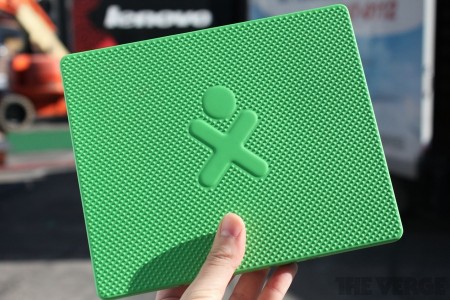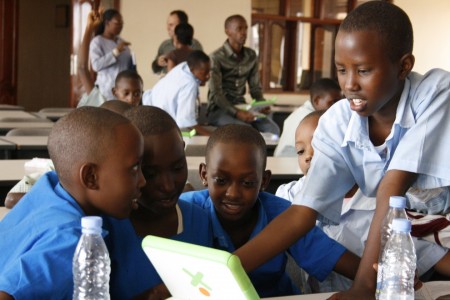Courtesy of OLPC Asia’s Richard Lai: a New Year’s Dragon made out of XOs, making the rounds near Hong Kong! Â To the delight of the passengers (and library visitors).


Courtesy of OLPC Asia’s Richard Lai: a New Year’s Dragon made out of XOs, making the rounds near Hong Kong! Â To the delight of the passengers (and library visitors).

Reposted with permission from the Eshibinga blog:
Last week we got the good news. Our class is soon going to get two more computers. That is great news because we are a class of 40 kids and and increasing… [they] have helped us learn most of the computer basics, writing, recording, games, music, etc etc. Recording activity was my favorite. When I grow up I want to be a photo journalist.
Our dream as a class is to have each kid own his or her own laptop. I think a computer has a private face. As much as computers do lots of public work, but I think and I stand to be corrected, that a computer is also personal. The reason I am saying this is because I have some personal matters in my life which I have typd and recorded on one of the laptop. It is no secret here in Eshibinga that my dad has been living with HIV AIDS. He does not have long to live. Every word he tells me is important. Every smile he gives me is precious, every prayer he makes for me and my three other siblings is memorable. After learning about the recording activity on the xo laptop, I asked Mr. Amunga to give it to me to go with it home. I sat my dad under his favourite tree. And I recorded his voice, his smile his face.
Later I realized that what I had recorded was so important. I don’t want it erased. It may be the only chance for my three sisters and I to hear and see our dad in future.
The advice dad was gave was very personal and very private. I don’t want my classmates to read watch or see the recording I made on the xo laptop. Neither do I want it erased. What do I do? Yesterday teacher announced that will get two more laptops. I want to talk to him to give me this particular one for keeps. It has the face of my dad, my history, my roots. I need to keep this recordings. They are too personal, too private, too precious. A computer has two faces the private and the public.
Joanna Stern, who has reviewed many OLPC models in the past, takes an in-depth look at the XO-3 prototype at CES, in a detailed review for The Verge. In addition to an excellent writeup, she interviews Ed McNierney while exploring the laptop in person, in what looks like Max Headroom’s office. They talk about everything from hardware and power to software and deployment.
They also took the best set of photos of the XO-3 and solar-cover to date!


As foreshadowed 18 months ago, an XO-3 prototype is debuting at CES this weekend, and will be shown off next week at the Marvell booth. Here is a sneak peek at what it looks like:

If you are heading to CES, you can stop by and see it yourself! Ping Giulia to set up an appointment, or drop by the Marvell booth. Charbax of olpc.tv will be on site as always, recording some video and interviews.
The XO-3 will sport a 1024×768 Pixel Qi screen, half-gig of RAM, and a Marvell Armada PXA618 chip. Some of the soft cover designs proposed so far include a built-in solar panel. More updates coming over the next week; for now, here is our CES press release.
The XO-3 is still planned to enter production at the end of this year.

Also: The first Marvell ARMADA-powered XO 1.75 laptop will begin shipping in March to school children in Uruguay and Nicaragua
SANTA CLARA, Calif. / LAS VEGAS (Jan. 9, 2012) – Marvell Semiconductor (Nasdaq: MRVL), a worldwide leader in integrated silicon solutions, and One Laptop per Child, a non-profit organization dedicated to helping every child in the world gain access to a modern education, demonstrated a version of the much-anticipated XO 3.0 – a low-cost, low-power, rugged tablet computer designed for classrooms around the globe – at the 2012 International Consumer Electronics Show.
“We’re proud to introduce the XO 3.0 tablet, showcasing the design, durability and performance features that make it a natural successor for our current laptops, which have been distributed to more than 2.4 million children in 42 countries and in 25 languages,” said Ed McNierney, Chief Technology Officer of One Laptop per Child. “The XO 3.0 builds on many of the technology breakthroughs we made with the XO 1.75, including the use of the Marvell® ARMADA® PXA618 processor, resulting in a significant decrease in power consumption-a critical issue for students in the developing world.”
“Marvell is committed to improving education–and the human condition-around the world through innovative technology for Smartphones, tablets and a myriad of new cloud-delivered services. Partnering with One Laptop Per Child is one way we can deliver a revolution where it matters most-to benefit children in some of the poorest places on the planet,” said Tom Hayes, Vice President of Corporate Marketing at Marvell, and a member of the OLPC advisory board. “Marvell has been with One Laptop per Child from the start, and we’re doing whatever it takes to help the organization realize its mission of providing meaningful educational opportunities to the 500 million school-aged children around the world.”
Marvell and One Laptop per Child also announced today that the XO -1.75 laptop will begin shipping to customers in March 2012. Over 75,000 units of the XO 1.75 have already been ordered by OLPC projects in Uruguay and Nicaragua. Both models use the Marvell ARMADA PXA618 SOC processor, which doubles the performance of the earlier XO 1 while using only half the power. The XO 1.75 features a sunlight-readable screen, and all other features and design characteristics of the two previous versions of the XO laptop.
The XO 3.0 tablet will also feature the Avastar Wi-Fi system-on-chip.
It is also the only tablet that can be charged directly by solar panels, hand cranks and other alternative power sources
Other features include:
• Updated Pixel Qi sunlight-readable display
• Choice of Android or Linux operating systems
• Unique charging circuitry to support alternate power sources
• Choice of laptop covers, including one with built-in solar panel
As we prepare for 2012, here is a quick look back at the past year of OLPC. We distributed our two millionth laptop (now 2.5M), and our largest programs in Latin America (Peru) and Africa (Rwanda) grew steadily. Austria’s Julieta Rudich and Journeyman Pictures produced a fine documentary about Plan Ceibal in Uruguay (the world’s first complete olpc program), and Peru provided XOs and compatible robotics kits to all of their urban schools.
In East Africa, we expanded our work with African nations and donors to improve education for children across the continent. We were invited by both the African Union and the UN to open an OLPC office in Addis Ababa, Ethiopia. Addis is a major hub for African diplomacy, and the support there for our mission has been stunning. We have become a full partner of the East African Community in Tanzania, and our recent country report on Rwanda has driven further interest in the region.

A Rwandan student workshop in Kigali
In the Middle East, we continued working with the Palestinian Authority, Israel and the UN to provide thousands of Palestinian children with XO laptops, integrating them into schools. It took ten months to work the laptops through customs in Gaza. But at a forum in Ramallah in June, teachers from Bethlehem and Gaza showed how OLPC was helping to end isolation and to excite learning for their children. Third grade girls in refugee camps are teaching others and writing computer programs. The testimony of these women to the power of persistence was extraordinary.
In Afghanistan, we founded a regional OLPC Afghanistan office, and briefed General Petraeus on the project. We believe that one laptop per child and connectivity, across the country, will transform this generation and their communities. Today we are working with the Education Ministry to support four thousand children in 10 schools, and are looking into expanding in Herat Province.
On the technical side, we focused on driving down laptop power needs by switching over to ARM chips in the XO-1.75 and upcoming XO-3 tablet. The tablet should be chargable by a solar panel that could serve as its carrying-case. We are studying new ways to help children learn to read, including where there are no schools at all.
In society, the idea that every child should have access to their own computer and to the Web – as a basic part of learning, whatever their family income – continued to spread. In addition to ongoing national programs in Argentina, Portugal, and Venezuela (for secondary students), two full-saturation laptop programs for older students are developing in India – an inexpensive tablet is being distributed to university students, and in Tamil Nadu dual-boot laptops from six different manufacturers are being provided to secondary students.
Reaching the least-developed countries in the world remains our goal and our most difficult challenge. While our largest deployments are funded directly by implementing governments, rural successes may be driven by foundations, NGOs, and individual donations. OLPC Rwanda, today one of the largest educational technology projects in Africa and part of a ten-year government plan, was seeded with ten thousand laptops given by Give One, Get One donors.
So to our supporters: thank you for your development, contributions, and collaboration, your feedback from the field, and your encouragement! This is all possible thanks to you.
Happy New Year to all — may 2012 bring you inspiration and discovery. We have some excellent surprises planned for the new year. And we would love to hear your reflections as well — please share stories from your own school projects in 2011.